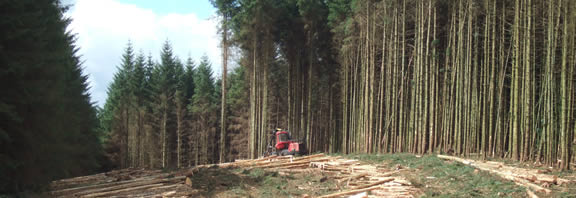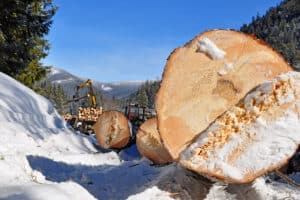As of April 5th, 2012, publicly-traded timberland-owning REITs posted YTD returns of nearly 10%, according to the Forisk Timber REIT (FTR) Index. This kept the sector in line with the overall lift across equity markets – the S&P is up 11% so far in 2012- and in the conversation with timberland investors who continue to test the opportunities for direct timberland investments across the United States. Looking forward, here’s our view for timberland investors interested in both future stumpage prices and the competition for timberland assets.
Timberland Ownership
Forisk’s 18-month study of timberland owners in the U.S. indicates that the top 249 owners and managers account for nearly 82 million acres of private timberlands. By acreage, these owners are concentrated, first, in the US South, and secondarily in the Pacific Northwest, Lake States and Northeast. The top 10 alone account for 32.5 million acres. Detailed analysis of these ownership groups highlight the continued shifting of acres to institutions, and the increased activity by private individuals and “family offices” in timberland markets. Long-term owners cite a belief that resources will continue to become scarce, and that hard assets – especially land – provide protection for value and against inflation.
Stumpage Prices Moving Forward
For the second consecutive year, Forisk’s localized pine sawtimber forecast hit within 4% of actual at the state-level. South-wide, Forisk’s regional pine sawtimber average of $26.57 per ton exceeded Timber Mart-South’s actual price of $23.97 for 2011 by 4.7%. The just-published 2012 ForiskForecast for the US South and Pacific Northwest develops three economic and forest industry scenarios. The baseline and “low growth” forecasts expect relatively flat to negative pricing in 2012 for pine sawtimber, with modest strengthening in 2014 as housing returns. Higher sawtimber prices require more than simply increased housing starts; prices require a suitable balance of forest industry capacity to lumber demand and production, with sawmills exceeding 85% utilization for six to twelve months to “reset the floor.”
Meanwhile, other market activities provide opportunities to supplement needed demand, including active export markets and the expansion of the Panama Canal. Forisk developed a high growth scenario that accounts for both strong economic and housing market growth, and potential increased log export activity from the US South by state. This scenario expects strengthening in 2012-2013, with prices in 2014 $2.86 per ton higher than the baseline forecast.
Investors Remain Interested in Timber Assets
If investor phone calls and coverage by the financial press provide sufficient clues, the market remains interested in the benefits of and outlook for timberland investments. Clay Risher, in his REIT Magazine article “Planting the Seeds for Timber REIT Growth” (March 14, 2012), cited Forisk’s research in emphasizing the range of options and diversity across public timber REITs. While Rayonier (RYN) lapped the field in 2011 thanks to its specialty fibers business, other firms, such as Weyerhaeuser (WY) have led in 2012 and, along with Potlatch and Plum Creek, expect to gain more directly from improved housing markets.
Still, investing in timber REITs differs from investing in timberland. Ellie Winninghoff, in her Financial Advisor Magazine article “Balance Sheets that Always Keep Growing” (March 28, 2012), summarized Forisk’s emphasis on the local and regional nature of timber REITs and timberland investment performance. In the end, geography matters for both publicly-traded and private-placement investment vehicles.
This content may not be used or reproduced in any manner whatsoever, in part or in whole, without written permission of LANDTHINK. Use of this content without permission is a violation of federal copyright law. The articles, posts, comments, opinions and information provided by LANDTHINK are for informational and research purposes only and DOES NOT substitute or coincide with the advice of an attorney, accountant, real estate broker or any other licensed real estate professional. LANDTHINK strongly advises visitors and readers to seek their own professional guidance and advice related to buying, investing in or selling real estate.










Add Comment